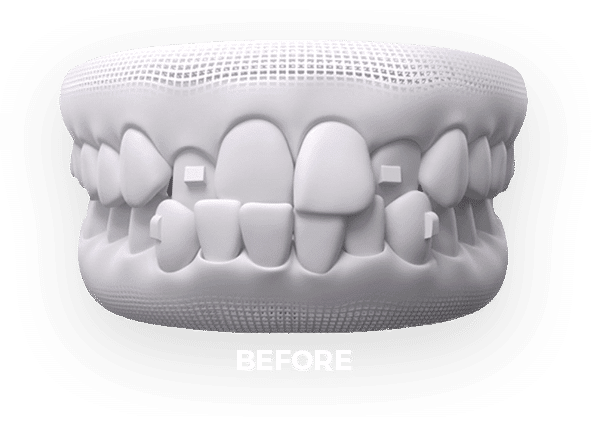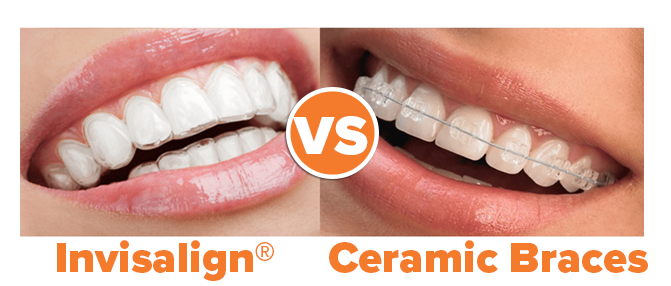The Price of Invisalign: Recognizing the Investment in Your Smile
The Price of Invisalign: Recognizing the Investment in Your Smile
Blog Article
Invisalign vs. Conventional Braces: Which Alternative Is Right for You?
When considering orthodontic treatment, the selection between Invisalign and conventional dental braces provides a number of vital factors that merit mindful assessment. Invisalign supplies a very discreet option with removable aligners, while conventional dental braces provide an extra noticeable yet effective solution for serious imbalance. Each choice encompasses distinctive advantages and downsides connected to appearances, convenience, treatment period, and cost. Comprehending these subtleties is critical for making an informed choice that straightens with your personal choices and way of life. The concern remains: which choice will ideal meet your orthodontic needs and expectations?
Overview of Therapy Choices

On the other hand, typical dental braces contain metal brackets and cables that are bound to the teeth. This method applies continual stress with time to accomplish placement. While reliable for complex orthodontic issues, traditional dental braces need normal visits for changes and can pose difficulties in keeping oral health due to the difficulty of cleaning around brackets and wires.
Both options have their qualities, and the choice frequently hinges on specific dental problems, way of life preferences, and client conformity. Inevitably, speaking with an orthodontic specialist is important for determining the most suitable therapy strategy tailored to private requirements. Comprehending the subtleties of each option can significantly affect the general success of orthodontic therapy.
Aesthetic Factors To Consider
A considerable aspect affecting the choice between Invisalign and traditional dental braces is the aesthetic allure each treatment provides. Invisalign aligners are crafted from clear plastic, making them virtually undetectable when put on. This very discreet look is particularly appealing to adults and young adults that might feel self-conscious regarding their orthodontic therapy. The capacity to maintain a natural smile throughout the placement procedure can considerably improve the client's self-confidence in specialist and social settings.
On the other hand, typical braces are composed of steel braces and cables, which can be extra visible. While improvements in orthodontic technology have brought about the advancement of smaller braces and tinted elastics, conventional dental braces still preserve an even more obvious profile. For some people, the visibility of dental braces may prevent them from looking for needed treatment.
Eventually, the option between Invisalign and conventional braces might depend upon individual preferences relating to looks. Patients that focus on discretion typically lean towards Invisalign, while those who are much less worried about exposure might select conventional dental braces. Recognizing the visual implications of each choice is critical for making an informed decision that aligns with one's lifestyle and preferences.
Convenience and Convenience

In terms of ease, Invisalign aligners are detachable, making it possible for individuals to enjoy their preferred foods without constraint and preserve optimal dental health. Brushing and flossing are simplified, as the aligners can be gotten throughout these routines, whereas conventional braces need cautious navigating around brackets and cables.
In contrast, traditional dental braces demand routine modifications, making them less practical for those with busy timetables. Overall, the convenience and comfort of Invisalign make it an appealing selection for numerous people looking for orthodontic treatment.
Therapy Period and Efficiency
While both Invisalign and conventional dental braces work in correcting dental imbalances, the period of therapy can differ dramatically in between both choices. Usually, Invisalign treatment can take anywhere from 12 to 18 months, relying on the complexity of the case. The clear aligners function by progressively changing teeth into their desired settings, and normal follow-ups with an orthodontist help guarantee development stays on course.
On the other hand, standard dental braces often call for a longer commitment, typically ranging from 18 months to 3 years. This results from their fixed nature and making use of cables and braces, which can be extra reliable for extreme misalignments and intricate instances (Invisalign). The therapy performance of standard braces is well-documented, as they permit for specific modifications and greater control over tooth movement
Ultimately, the choice between Invisalign and standard braces may rest on both the anticipated treatment period and the particular oral problems available. Consulting with an orthodontist is vital, as they can provide tailored referrals based upon individual needs, making sure the picked approach straightens with wanted durations and results.
Cost Comparison and Insurance Policy Choices
Cost plays a considerable role in the decision-making procedure for individuals thinking about orthodontic therapy, whether choosing for Invisalign or conventional braces. On standard, the cost of Invisalign ranges from $3,000 to $8,000, while traditional dental braces commonly cost between $2,000 and $6,000. Aspects affecting these prices consist of the complexity of the instance, the duration of therapy, and geographical area.
Numerous dental insurance policy strategies give partial protection for orthodontic therapies, but the specifics can differ widely. Normally, standard braces may be extra regularly covered by insurance strategies contrasted to Invisalign, which some insurance firms categorize as an aesthetic read this treatment.
Furthermore, a number of orthodontic methods use adaptable payment plans, making both therapy choices more available. Patients must ask about prospective funding alternatives and discount rates for upfront repayments. Examining the complete price, including insurance benefits and layaway plan, is vital for making an informed choice that lines up with both visual choices and budget plan considerations.

Verdict
In recap, the selection in between Invisalign and standard braces hinges on several aspects, consisting of visual preferences, comfort, therapy duration, and cost. Invisalign provides a very discreet, removable option that facilitates dental health and dietary versatility, while conventional braces may be preferable for complex oral problems and often come with a lower cost factor. Inevitably, examination with an orthodontist is vital to analyze private situations and determine the most appropriate therapy choice for attaining optimal oral alignment.
When taking into consideration orthodontic therapy, the option in between Invisalign and standard dental braces provides numerous crucial elements that merit cautious assessment.Comparing Invisalign and conventional braces exposes distinct therapy choices for orthodontic Click Here correction.While both Invisalign and typical braces are efficient in fixing dental imbalances, the duration of treatment can vary substantially in between the two choices.Price plays a considerable duty in the decision-making procedure for people taking into consideration orthodontic therapy, whether deciding for Invisalign or typical dental braces.In summary, the choice in between Invisalign and typical dental braces hinges on numerous elements, consisting of visual choices, comfort, treatment period, and cost.
Report this page